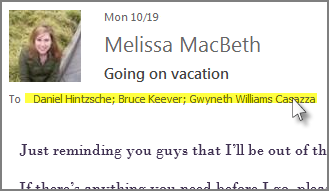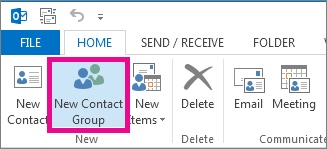Use a contact group (formerly called a “distribution list”) to send an email to multiple people—a project team, a committee, or even just a group of friends—without having to add each name to the To, Cc, or Bcc line individually.
-
On the Navigation bar, click People.
Note: You can find People in one of two places on the Navigation bar.
If you're using the compact Navigation bar, click the People icon.

If you're using the expanded Navigation bar, click the word People.

-
Under My Contacts, select the folder where you want to save the contact group. Usually, you'll select Contacts.
-
On the Ribbon, select New Contact Group.
-
Give your contact group a name.
-
Click Add Members, and then add people from your address book or contacts list.

Note: To add someone who is not in your address book or contacts, select New E-mail Contact.
-
Click Save & Close.
To learn how to use your new contact group, see topic : Send an email message to a contact group.
Use an email to create a contact group
If you’re always emailing the same group of people, you can create a contact group (previously called a distribution list) that includes all of the recipients by using a previous email that you sent to them. Then, the next time you want to contact them or schedule a meeting with them, you can add the contact group to the To line of your message, instead of adding each person individually.
-
Open an email that was sent to the people you want to include in the contact group.
-
In the To or Cc box, highlight all the names with your mouse.

-
Right-click your selection, and then click Copy, or press Ctrl+C.
-
In the main Outlook window (not in the opened email message), click People on the Navigation bar.

-
Click New Contact Group.

-
Type a name for your contact group, like Special Projects.
-
Click Add Members > From Outlook Contacts.

-
In the window that opens, right-click inside the Members box, and click Paste, or press Ctrl+V.
-
Click OK.
The people from the email will appear as a list of members for your contact group.

-
Click Save & Close.
Contact groups show up in your list of contacts, along with individual people. You can tell the difference by the icons that appear to the left of the names in List view. The card icon is for individual contacts and the people icon is for contact groups.

Finally, you can always add people or remove people from the contact group later.